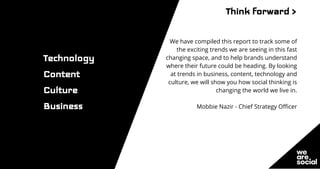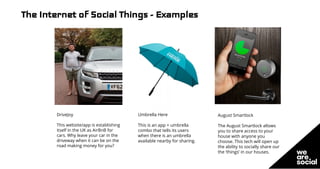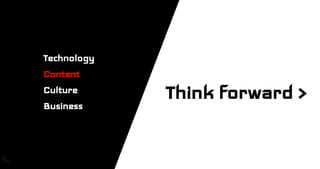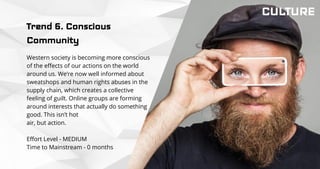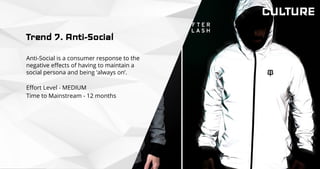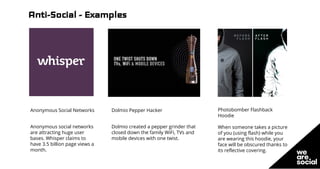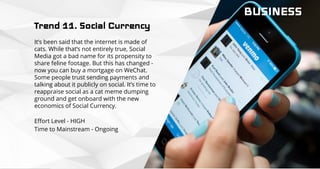We Are Social: Think Forward 2016
- 2. Think forward > Introduction Mobbie Nazir - Chief Strategy Officer
- 3. “No one can see into the future. What I try to do is outline possible "futures" - although totally expected inventions or events can render predictions absurd after only a few years. The classic example is the statement, made in the late 1940s, by the then chairman of IBM that the world market for computers was five. I have more than that in my own office.” Arthur C Clarke
- 4. Think forward > Predicting the future is a fascinating topic. It is a dream as old as history, from consulting the Oracle at Delphi in ancient Greece to the work of Nostradamus in Medieval France. This fascination has persisted into modern history which is littered with visions of the 21st century that never came true - but that doesn’t stop people and organisations from trying to see what is around the next corner. Today, we make forecasts all the time - from predicting traffic flows to the demand for turkeys at Christmas.
- 5. By now it is widely recognised that social media is changing our world. It’s one of the biggest shifts in culture and society since the industrial revolution and it is only just getting started. Research methodologies and predictions of future events are not the only traditional business models that social media has turned on its head. Traditionally, these predictions have been based on what people have already done - but now with the wealth of real-time data available at our fingertips, we are starting to see models of prediction of how people are “about to act”. In April 2011, IARPA announced the Open Source Indicators program (OSI), which would award substantial grants to three research groups to develop models that ingested publicly available data like tweets, blog posts, and news articles to anticipate “significant societal events,” such as unrest, epidemics, and economic instability.
- 6. It’s important to remember that people had a desire to connect with each other way before the rise of social platforms. Social behaviour is hard-wired into our DNA. It is how we define ourselves and build relationships with others. It is a powerful driving force which brands and organisations can tap into to help them connect and engage with their audiences in more engaging, useful and meaningful ways. The “sharing economy” is a disruptive economic force that creates new sources of supply. Whether this involves underused assets (private cars, spare bedrooms) or labour (people willing to fill in a few hours as taxi drivers, personal shoppers or couriers), it taps resources that could not be effectively organised before. Social platforms have also played an important role in many elections around the world, including in the U.S, Iran, and India. From trends such as these, we can see that social media can be a significant catalyst for success by empowering people and fuelling ideas.
- 7. Think forward > We have compiled this report to track some of the exciting trends we are seeing in this fast changing space, and to help brands understand where their future could be heading. By looking at trends in business, content, technology and culture, we will show you how social thinking is changing the world we live in. Mobbie Nazir - Chief Strategy Officer Technology Content Culture Business
- 8. Think forward > Methodology We have a trendspotter in each of our 11 global offices who were briefed to look for key social trends in business, content, culture and technology. We reviewed the trends monthly and built proof of these trends in each market.
- 9. What is a Trend? We know something is a trend when there are many different groups of people trying to find solutions to similar goals. If it’s just one good idea, then it’s not a trend. A trend is a collection of innovators working (usually) separately to solve a problem. For example, when we saw several websites and apps streaming intimate and first-person views of people’s lives we called this trend Voyeurism 2.0. This is a trend because each of these businesses were trying to serve our natural curiosity to be nosey and compare our choices to our peers.
- 11. TECHNOLOGY Trend 1. The Internet of Social Things The idea of sharing your house, your bed and your bathroom with a stranger would have been unimaginable a few years ago. But AirBnB changed that, and it’s now worth billions. AirBnB gave us the capacity to share objects that previously we had to own. The Internet of Social Things is a trend which is seeing us becoming happier to share everyday objects socially through our smartphones. Bikes, umbrellas - nothing is safe... Effort Level - HIGH Time to Mainstream - 12 months
- 12. Umbrella Here This is an app + umbrella combo that tells its users when there is an umbrella available nearby for sharing. August Smartlock The August Smartlock allows you to share access to your house with anyone you choose. This tech will open up the ability to socially share our the ‘things’ in our houses. The Internet of Social Things - Examples DriveJoy This website/app is establishing itself in the UK as AirBnB for cars. Why leave your car in the driveway when it can be on the road making money for you?
- 13. The Internet of Social Things What will happen next? In the future we won’t own as many things as we do now. We’ll hire them from each other via socially connected services like DriveJoy. Using technology like the August Smartlock we will hire out our household appliances when we’re not there and have them put them back in time for us to use them. How many of the items in your house would you miss if they weren’t there? Would you prefer to make a pound a day for hiring out your hiking boots or have them sit there doing nothing? The technology is there to allow this to happen.
- 14. TECH Trend 2. Wearable Social The forecasted wearable device market value for 2018 is $13Bn. We are entering a world of “Wearable Social” where movement, heartbeats and emojis are a new form of social language. Effort Level - MEDIUM Time to Mainstream - 18 Months
- 15. Wearable Social - Examples PPLKPR This app/wearable combo captures biometric data and gives instant feedback on how your body responds to people in real life situations. Are you ready to find out what your body says when you’re around Neil from accounts? Digital Touch Drawing on your watch, or sending a heartbeat, a tap or an animated emoji may sound gimmicky, but Apple’s Digital Touch has tapped into one of the more powerful opportunities wearable tech offers: the ability to further evolve communication, into a nonverbal format. Hands Free Tinder Why waste time swiping when you can let your heart decide who is the right match for you on Tinder?
- 16. Wearable Social What will happen next? We will see an exclusively wearable social network emerge, or the real shift will occur when the first affordable wearable goes mainstream. When that happens brands need to be ready for communicating in a new, more personal language.
- 17. Trend 3. Social VR There has been a lot of buzz recently around virtual reality (VR) and its potential as a new hardware device and software platform. The technology, which immerses the user in a computer-generated or photo-real simulation of an environment, is slowly gaining momentum. Currently most VR/360 experiences are a one person affair. VR 2.0 is almost upon us which will allow us to communicate socially in a virtual environment. Effort Level - MEDIUM Time to Mainstream - 12 Months TECHNOLOGY
- 18. Social VR - Examples AltspaceVR This is a social platform for virtual reality that has recently received huge VC investment. Users can meet up in a VR setting in the form of avatars to have conversations, share online content and play games. Facebook Innovates with VR Facebook has bought Oculus Rift for $2 billion, which guarantees its future as a comms platform. Zero Latency “It’s like being inside a computer game”. This Aussie immersive VR game lets players fight off zombies as a team in a 3D world.
- 19. Social VR What will happen next? The future of VR/360 will be hugely affected by how Facebook integrates with its Oculus Rift platform. If they can crack how to get people to communicate socially whilst wearing a VR headset, then Social Virtual Reality will be a, erm, reality.
- 21. Trend 4. Voyeurism 2.0 When social media went mainstream it was exciting to connect with friends, colleagues and old school pals online. But once that novelty wore off, we started to look further afield. We’ve developed a taste for peering over the garden fence into the intimate lives of others. Effort Level - MEDIUM Time to Mainstream - 6 Months CONTENT
- 22. Voyeurism 2.0 - Examples Mukbang This phenomenon satisfies millions of people’s urges to watch other people stuff their faces. Young girls eating chicken seems to be driving most of the traffic. Check it out. Watch Me Date This was the Guardian’s attempt to capture the ins and outs of a date in real time. Two people went for a date and both wore Google Glass. You can explore the date from both perspectives. Watch me code If watching people eat chicken isn’t your thing, maybe coding is. The Watch Me Code website is a treasure trove of coders perfecting their art in front of your eyes.
- 23. Voyeurism 2.0 People love the radical transparency that Voyeurism 2.0 brings. You can’t fake this kind of authenticity. Brands will have to find a way to be warts and all, no matter how painful, because anything less will get overlooked and even outed for its phoniness.
- 24. Trend 5. Big Social Data Say ‘Big Data’ out loud and everyone within six feet will know you work in marketing. But Big Data is often misunderstood and misused. The ‘Big Social Data’ trend is seeing smart brands mine conversations on social to help them create products their audiences really want - in real time. Effort Level - HIGH Time to Mainstream - 18 Months CONTENT
- 25. Big Social Data - Examples Crowd Sourced Gigs Snow Patrol base all of their tour dates and setlists on locally gathered digital user data from over 30 different sources. All Things Hair Unilever is the posterchild of this trend. All Things Hair learns what hair-styling tips women search for on Google and forwards these queries to a team of video bloggers, who are paid by Unilever to create tutorials. TOPSHOP Pinterest Topshop teamed with Pinterest to create a piece of tech which scans your pins and reveals your colour DNA. Using this palette, Topshop offers matching items from their website.
- 26. Big Social Data What will happen next? As brands start to develop products in near real time based on insights gathered from conversations on social, they will eventually have to change the way their businesses are set up. Could a soft drinks brand release a new flavour within a week if that flavour started to gain social traction? Could we see vending machines that produced bespoke mixes and flavours on the spot, depending on what was being talked about on social?
- 28. Trend 6. Conscious Community Western society is becoming more conscious of the effects of our actions on the world around us. We’re now well informed about sweatshops and human rights abuses in the supply chain, which creates a collective feeling of guilt. Online groups are forming around interests that actually do something good. This isn’t hot air, but action. Effort Level - MEDIUM Time to Mainstream - 0 months CULTURE
- 29. Conscious Community - Examples Be My Eyes This app connects blind people to a sighted volunteer using a live video chat. The volunteer can then see the blind person’s surroundings and answer questions using their phone’s camera. #SPCSunday This Australian canned fruit brand was on the brink of collapse. #SPCSunday was a week long community campaign that saved the hundred-year-old business from laying off its employees. Made in a Free World This is a community of people who are conscious of the fact that supply chains can, and often do, use slavery and child labour. MIAFW built the world's first software that locates and addresses these risks.
- 30. Conscious Community What will happen next? People are starting to feel the power of the crowd first hand, and it’s becoming mainstream. A brand’s ethics will increasingly become a matter of hygiene instead of an optional way to add value. CSR won’t be a choice, but a necessity.
- 31. Trend 7. Anti-Social Anti-Social is a consumer response to the negative effects of having to maintain a social persona and being ‘always on’. Effort Level - MEDIUM Time to Mainstream - 12 months CULTURE
- 32. Anti-Social - Examples Anonymous Social Networks Anonymous social networks are attracting huge user bases. Whisper claims to have 3.5 billion page views a month. Photobomber Flashback Hoodie When someone takes a picture of you (using flash) while you are wearing this hoodie, your face will be obscured thanks to its reflective covering. Dolmio Pepper Hacker Dolmio created a pepper grinder that closed down the family WiFi, TVs and mobile devices with one twist.
- 33. Anti-Social What will happen next? We are seeing a rise in Anti-Social experiences being viewed as luxury moments. Will social end up being the new smoking?
- 34. Trend 8. Social Status Seekers Seeking Social status isn’t new, but the technology enabling this behaviour is. Effort Level - MEDIUM Time to Mainstream - Ongoing CULTURE
- 35. Social Status Seekers - Examples Facetune This is the No1 app in the photo and video section of the iTunes app store. The app allows you to easily apply photoshop-esque techniques to your selfies to ensure you always look your best. Kander Kander is a social photo-sharing app that uses a left or right swipe to allow users to deliver snap judgments on their friends’ photos before they post them on social. Lily Drone Sod the selfie stick. Meet Lily, a drone that follows you to take action shots while you do crazy snowboard maneuvers for you to post on Instagram.
- 36. Social Status Seekers What will happen next? It’s a primal instinct to want to ‘fit in’ and be seen as attractive, because this ensures your connection to the tribe and your success within it. Innovators haven’t ever stopped delivering new ways of satisfying these urges. Now we’re connected socially, this trend will explode in the next few years.
- 38. Trend 9. Community Commerce Community Commerce is where positive behaviour, social and finance collide. We are starting to see communities rally around common causes for good, with positive financial outcomes for all involved. Effort Level - HIGH Time to Mainstream - 18 months CULTURE
- 39. Community Commerce - Examples Hand Up Hand Up is kickstarter for homeless people. Each Hand Up user, representing a homeless person on the website, pitches for donations to help with rent, mobiles and health. Minneapolis Co-Op This socially driven cooperative in Minneapolis enables people to buy, renovate, and manage commercial and residential property, helping community stakeholders shape their neighbourhood through social. Paystobesocial This is an app which pairs you up with people making the same train journey, so you can nab a group discount.
- 40. Community Commerce What will happen next? As more examples of community commerce gain traction, brands will feel the pressure to empower their customers to adopt this innovative model for their own benefit.
- 41. Trend 10 (Inc)ubators Some of the most innovative businesses are giving startups a financial leg up in return for first dibs on their genius. The excitement of having some underpaid startups in the building can lend a feeling of being an innovative company, but the reality of integrating three man team operations within behemoth multinational companies is no mean feat. Effort Level - HIGH Time to Mainstream - 18 months BUSINESS
- 42. (Inc)ubators - Examples Unilever Foundry Unilever Foundry is the brand’s plan to collaborate with innovators to make sustainable living commonplace. Wayra Wayra is Telefónica’s startup accelerator that gives startups a $50,000 kick, access to mentors and its millions of customers. Microsoft Ventures Microsoft Ventures is a revolving door of exciting startups. Their mission is to empower and grow early stage startups so they can realise their potential.
- 43. (Inc)ubators What will happen next? (Inc)ubators are becoming more commonplace, but there’s a fine line between attempts at innovation and the production of geniunely disruptive products. Best practice is yet to be established and it will be many years until this approach has been proven to be truly effective.
- 44. Trend 11. Social Currency It’s been said that the internet is made of cats. While that’s not entirely true, Social Media got a bad name for its propensity to share feline footage. But this has changed - now you can buy a mortgage on WeChat. Some people trust sending payments and talking about it publicly on social. It’s time to reappraise social as a cat meme dumping ground and get onboard with the new economics of Social Currency. Effort Level - HIGH Time to Mainstream - Ongoing BUSINESS
- 45. Social Currency - Examples Barclays Pay By Tweet Barclays are the first British bank to allow people to make payments to each other and small businesses using just their Twitter handle. Snapcash Snapchat partnered with payment system Square to create money transfers on Snapchat called Snapcash. Once Snapchat users have linked their debit card in the app, they can send Snapcash to anyone in their contact list who is eligible to receive Snapcash. Venmo The PayPal owned Venmo is a way to pay your mates for stuff while being social about it at the same time. You can exchange payments with people you know via your smartphone, linking to your Facebook friends and email contacts, as well as your bank account.
- 46. Social Currency What will happen next? Ultimately, people on social want to spend the least amount of time doing mundane financial tasks. If social networks can provide a consistent and trustworthy way of transacting with financial services then they have the ability to draw traffic (and eyeballs) away from the more traditional methods.
- 47. Think forward > Next Steps So what should you do with all these trends? Good question. We can help you take these social thinking trends and turn them into actions for your brand. If you’ve got the appetite to innovate, we can walk you through the process one step at a time. The first step is to talktous@wearesocial.net







